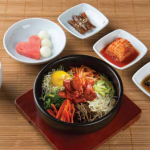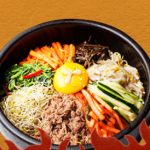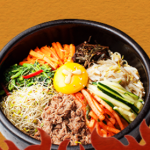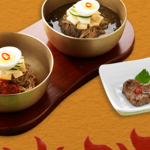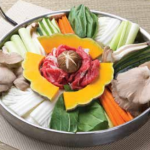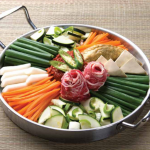Korean cuisine is a vibrant and diverse gastronomical delight that has gained immense popularity across the globe. With its bold flavors, unique ingredients, and captivating presentation, Korean food offers a delightful experience for both the adventurous foodie and the seasoned connoisseur. In this blog post, we will take you on a culinary journey through some of the most beloved Korean dishes. From spicy and hearty stews to savory barbecue and mouthwatering street food, get ready to tantalize your taste buds and explore the wonders of Korean cuisine!
Introduction: The Essence of Korean Cuisine
Korean cuisine, known as hansik, is deeply rooted in tradition and reflects the rich cultural heritage of the Korean people. The foundation of Korean cooking lies in a harmonious blend of simplicity, balance, and a focus on natural flavors. With an emphasis on seasonality and freshness, Korean dishes are often vibrant and colorful, filled with an array of ingredients that stimulate all the senses.
Exploring the Popular Korean Dishes
1. Bibimbap – Iconic Rice Bowl
– Transform your mealtime into a colorful affair with Bibimbap, a signature Korean dish that literally means “mixed rice.” This vibrant bowl is traditionally composed of steamed rice topped with an assortment of sautéed vegetables, marinated meat, a fried egg, and a dollop of zesty gochujang (chili pepper paste). The magic lies in the mixing process, where all the ingredients are stirred together, creating a symphony of flavors that dance in your mouth.
2. Kimchi – The Quintessential Sidekick
– No Korean meal is complete without a side of Kimchi, a spicy and tangy fermented cabbage dish. Bursting with probiotics and an explosion of flavors, it is made by salting and preserving cabbage with a combination of seasonings, including garlic, Korean chili powder, and fish sauce. Kimchi adds a delightful punch to any dish, and even though it is typically served as a side, it can also be used as an ingredient in countless other Korean recipes.
3. Samgyeopsal – Mouthwatering Grilled Pork Belly
– Sizzle your taste buds with Samgyeopsal, a popular Korean barbecue dish consisting of thick, fatty slices of pork belly expertly grilled at your table. What makes this dish truly enticing is the interactive experience it offers. You get to grill your own meat just the way you like it, creating a deliciously charred exterior and a juicy, melt-in-your-mouth interior. Wrap each delectable bite in a crisp lettuce leaf, add some ssamjang (a spicy dipping sauce), and enjoy the explosion of textures and flavors.
4. Japchae – Glass Noodle Extravaganza
– A harmony of flavors and textures, Japchae is a stir-fried noodle dish that combines translucent sweet potato noodles with an array of colorful vegetables. The dish is lightly seasoned with soy sauce and sesame oil, creating a delightful balance between the mild sweetness of the noodles and the umami of the vegetables. Japchae is often served as a side dish or enjoyed as a main course, showcasing the versatility of Korean cuisine.
5. Tteokbokki – Spicy Rice Cake Delight
– Prepare your taste buds for a fiery adventure with Tteokbokki, a beloved street food snack in Korea. This dish consists of cylindrical rice cakes simmered in a spicy gochujang-based sauce, creating a lip-smacking combination of sweet, spicy, and chewy goodness. Topped with fish cakes, fried egg, and green onions, it offers a tantalizing texture and a burst of flavors. It is a staple snack found in street vendors throughout Korea and is sure to leave you craving for more.
Conclusion: A Culinary Journey to Remember
Korean cuisine is a treasure trove of exciting flavors, textures, and culinary artistry. From savoring the earthy tones of bibimbap to relishing the sizzling aroma of samgyeopsal, each dish tells a tale of tradition, passion, and innovation. So, whether you’re exploring Korean food through restaurant delights or whipping it up in your own kitchen, take a leap into the enchanting world of Korean cuisine and embark on a culinary adventure you won’t soon forget!
Frequently Asked Questions (FAQs)
Q1: Are Korean dishes always spicy?
– While many Korean dishes have a spicy component, not all Korean food is spicy. Korean cuisine encompasses a diverse range of flavors, and you can find both mild and intensely spicy options to suit your taste preferences.
Q2: Can I find vegetarian options in Korean cuisine?
– Absolutely! Korean cuisine offers several vegetarian dishes, especially due to the prominence of vegetables in their culinary traditions. Bibimbap can easily be made vegetarian by omitting the meat, and dishes like Japchae often include an abundance of vegetables, making them suitable for vegetarians.
Q3: Where can I try authentic Korean cuisine if I’m not in Korea?
– Korean restaurants and eateries can be found all around the world, making it easier than ever to indulge in authentic Korean flavors. Check local listings or try exploring areas with a significant Korean population to find a restaurant that offers traditional Korean cuisine.
Q4: Are Korean dishes heavy on the palate?
– Korean cuisine strikes a delicate balance between complex flavors and maintaining lightness. While some dishes may have rich, hearty flavors, they are often balanced by the use of vegetables, fermented ingredients, and delicate seasonings, resulting in a harmonious combination that is satisfying without feeling heavy.
Q5: Can I substitute certain ingredients in Korean recipes if I cannot find them?
– Korean cuisine often utilizes specific ingredients that contribute to its unique flavors. However, some ingredients can be substituted to some extent. For example, if you cannot find traditional Korean chili powder, you can use a combination of regular chili powder and paprika. Exploring substitutions can help approximate the flavors, but keep in mind that the result may differ slightly from the authentic dish.

